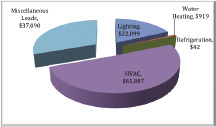Energy is a significant percentage of the overall cost for operating commercial and industrial properties. The larger the square footage and the more process equipment, the higher the costs to light, heat, cool, and operate the space. Commercial energy audits can help identify inefficiencies, reduce energy costs, and improve the bottom line. Many utilities offer incentives, making the audit inexpensive, and in some cases a utility may pay for the full cost of a detailed study targeted at reducing or normalizing the utility's demand to provide energy.
Ideally, energy audits should yield much more than recommendations for swapping incandescent light bulbs for compact fluorescent or light emitting diodes (LEDs). Today's energy audits offer recommendations not only on energy conservations measures (ECMs) but simple, no-cost Operational Measures (OMs) that can help property owners reduce costs without capital expense. Cost-reduction measures may often be as simple as informing site personnel on when to run certain equipment to reduce demand charges. For example, many residential consumers have heard that dish washers or clothes dryers should be run at night, when energy costs are cheaper (e.g. during off-peak hours). This practice can be extrapolated to commercial industries, where changes in operational procedures can have a dramatic impact on the demand charges for a Time of Use (TOU), Commercial (C) or Industrial (I) rate class account.
Demand charges are based on the highest demand in kilowatts (kW), which are monitored in 15-minute intervals by the utility. Running a large pump or similar equipment during peak hours can set the peak for that month. Simply running the equipment during off peak hours, when the total energy load at the building is lower, is a no-cost OM that can save an average of $6 per kW per month. Peak hours vary from utility to utility, but generally run from 8:00 a.m. to 9:00 p.m. daily, Monday through Friday.
Most commercial energy audits will include a detailed review of how and when each energy consuming device is operated, to model and predict energy cost savings. It is often beneficial to monitor and measure the actual energy use both before and after ECMs or OMs are implemented as part of the measurement and verification process.
"The typical cost savings uncovered by an energy audit is on the order of 5-20%" said Michael Skroski, a mechanical engineer and certified energy manager with Weston & Sampson's Energy Group. "Many of the ECMs and OMs we recommend have simple paybacks of one year or less, so the user sees a cost reduction right away."
Stephen Wiehe, PG - energy group team leader at Weston & Sampson Engineers and is a monthly contributing Environmental Consultant author for the New England Real Estate Journal's Green Building section.
Tags:








